Intro to Tech Bindings 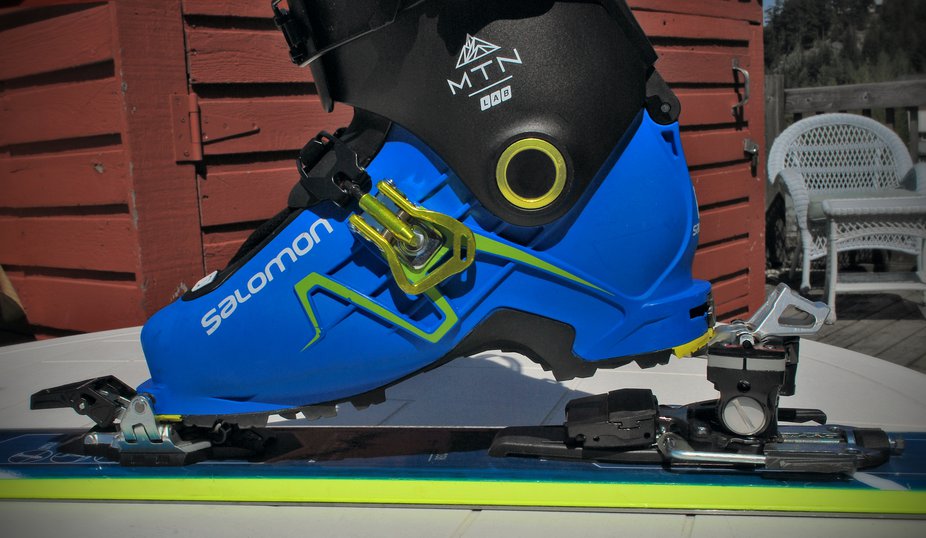
This week I have 2 touring boot reviews, the Salomon MTN Lab and the Atomic Backland. Both these boots are tech binding compatible and in the case of the Backland, tech bindings are your only option, but there is often a lot of confusion around how tech bindings work and also the type of skiing they are good for.
To complicate matters even more there are a new generation of tech bindings offering DIN release values and even in the case of the Marker Kingpin, an alpine style heel, but the fundamental way in which most of these bindings work is very similar and actually quite straight forward.
Once you understand the basic function of a tech binding, it all becomes much easier and that is exactly what I am going to show you in this article. Hopefully by the end you will feel more confident with tech bindings and may even consider trying them out.
I should say firstly, I am in no way an expert on all things touring, so this will not be super in-depth but should hopefully give you the info you need to get started with tech bindings.
History
To understand tech bindings, it helps to understand the reason they were first invented. Traditionally touring bindings were more similar to the frame style we have today such as the Marker duke or Salomon Guardian.
To hold the boot in place, there had to be a plate or frame between the heel and toe of the binding just like the Duke uses. This frame style although functional was not as light as it could be as the frame always adds weight to the overall binding.
What was needed was a way to eliminate the frame and this is what Fritz Barthel along with his father Manfred Barthel, began experimenting with in the early 1980's. Their concept was to use the boot as the connecting device between the heel and toe of the binding. By building inserts into the boot they were able to create a separate heel and toe unit which could both allow the boot to pivot at the toe for hiking but also hold the boot firmly in place for downhill skiing.
By eliminating the connecting parts they were able to produce an extremely light weight binding which operated in a very similar way to the current tech bindings.
The Brand Dynafit had a patent on the tech binding design for years which allowed them to become the market leader in touring bindings. They are still to this day the biggest Brand when it comes to tech bindings but their patent recently expired and this has led to a lot of new tech bindings from brands including G3, Pulm and Fritschi and even some of the bigger alpine brands have tech bindings in development.
Function
Most Tech bindings function in a fairly similar manner and to demonstrate I have a pair of Dynafit Radical ST bindings. The Radical is one of Dynafit's top selling bindings and rather then going for a full light weight build it is designed with more aggressive riding in mind, having said that they still only weigh 531g so not exactly heavy.
Initially looking at the binding on the ski, it may be a little confusing to work out how it functions. Unlike an alpine binding where you first position the toe of the boot and then step down with the heel, with a Tech binding you first secure the toe.

The toe piece of the binding has tow small Steel pins and these match up to 2 metal inserts on the toe of the boot. To step into the toe piece there are a number of ways. The easiest is to insert one of the pins into the boot insert and then roll the foot over onto the other pin. Another way of doing it and the way I normally do it, is to simply eyeball where the inserts are in the boot and then step down into the toe. The toe piece when you step down will close both wings so if you have everything lined up, the wings holding the pins will close onto the boot.
Its always a good idea to wiggle the boot around in the toe a little before stepping down into the heel. Sometimes you may slightly miss an insert with a pin and although you can step into the heel the toe may not be fully secured.

With the toe of the boot in place and you have the binding in ski mode you simply step down and the two pins engage with the boot. The heel insert is shaped a little like a triangle, with the narrower end pointing down. The two pins on the binding can open slightly to allow the boot to slide down, but once over the heel bracket they snap firmly into place securing the heel. How easily these pins open is controlled by the vertical release which I will cover later.
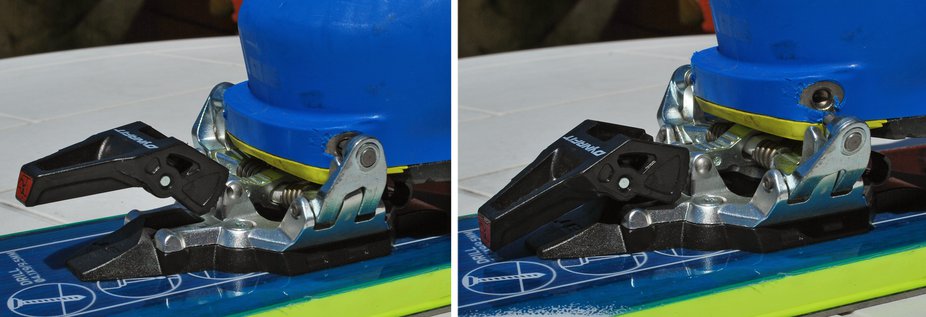
Taking the foot out of the binding is also unlike an alpine binding. Rather then pushing down the heel, you push the small lever on the toe piece. This lever opens the wings, releasing the toe of the boot. With the toe released you can simply turn your heel away from the heel piece to release the pins from the heel. The fact you never release the heel can be confusing but if you remember you release the toe and step out of the heel you should be ok.

The binding on the left is in Ski mode, the one on the right in Tour mode
Putting the binding into touring mode is achieved by turning the heel unit. The tour mode works by simply rotating the heel so the pins are no longer facing the boot, meaning the heel wont be held by the binding and you are free to walk.
To change the heel from ski to tour you first push down the brake, then turn the heel 90degrees clockwise. Turning the heel engages a small tab which holds the brake up out of the way when touring. It also rotates the two heel pins out of the way so the boot is free to move up and down.
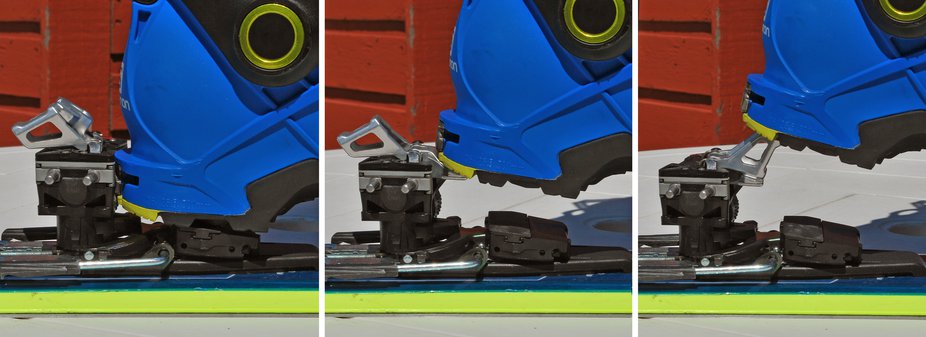
The heel has two small metal risers which can be flicked down to change the angle at which the boot sits. For steeper climbs it can help to use the risers to keep you in a more comfortable climbing position. One big benefit of tech bindings is the truly flat tour mode which is achieved by using neither riser. I use the flat mode a lot personally and find unless it's steep it is usually the most comfortable position for me.
When you are ready to ski again you simply turn the heel unit back 90degrees anti-clockwise. This re-engages the brake and rotates the heel pins back into position to hold the boot in place.
Once you have played with the bindings a bit and have practiced stepping in and out they really don't seem so complicated and you can become just as fast getting in and out as you are with regular alpine bindings.
Safety
Unlike Alpine bindings which have to meet many industry standards and also conform to DIN standards there are no real standards for touring bindings.
The Dynafit Radical does have release settings but these do not equate to DIN settings.

The image on the left shows the vertical release setting, the middle shows the Lateral setting and the image on the right shows both.
The other notable difference to alpine bindings is there is no adjustment on the two piece and instead the heel unit has 2 adjusters. These set the vertical (forward) and lateral (sideways) release values. These settings work independently of each other and can be set differently if required. The vertical release stops the pins from opening which could release the heel of the boot. The lateral release stops the heel of the binding from turning which could initiate a release from the toe, as well as the heel.
The way the boot releases on the Radical and many other Tech bindings, is with a two stage release. Firstly the heel will rotate and then the wings of the toe will open to release the boot.
Some bindings like the Fritschi Vipec do work slightly differently, having the toe release first but in general most tech bindings use a two stage release starting from the heel.
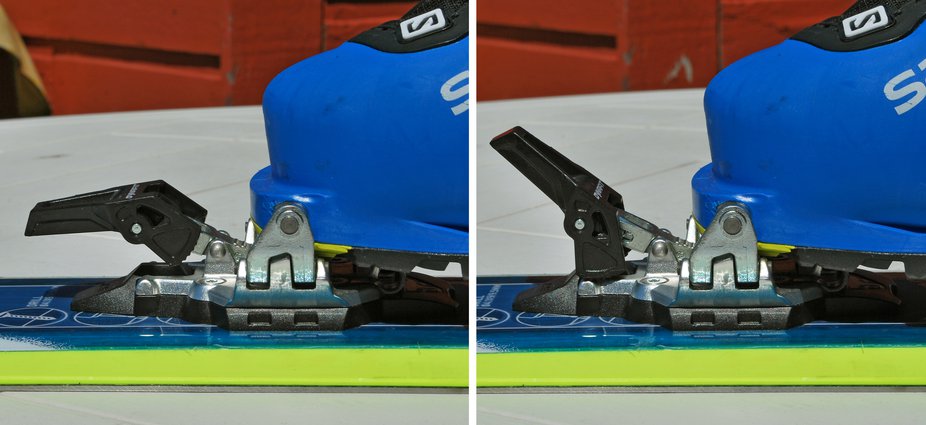
You may have heard of locking the toe and this is done to ensure the toe of the boot stays in place when skinning up. When you do a quick turn its quite easy to step out of the toe if its not locked, so by pulling up the lever at the front of the binding, you can lock the toe into the binding.
Traditionally to ski you would push the lever down to allow the toe to open more easily but it is possible to ski with the toe locked however the release of the boot will be very inconsistent and could be quite dangerous.
I do find myself skiing with the toes locked most of the time as I like the added bit of security of knowing if I push hard I wont inadvertently release the toe. This does however bring up issues where if you have a slow fall the ski is not coming off.
In big falls I was finding that even with the toes locked, once the heel released the toe would follow, but locking the toes does give me a little more confidence in bigger terrain but it certainly comes at a price.
Its hard to equate the release of a tech binding to that of an alpine binding. There are many factors involved but it does roughly feel similar to DIN, so a lateral and vertical of 10 on a Radical will feel similar to an alpine binding set to a DIN of 10, but remember it is not the same so don't presume you will be good just setting them the same as your alpine binding.
It would be nice to see more of a drive towards industry standards with tech bindings, especially with them growing in popularity. Getting tech bindings to conform to DIN standards would make me feel much safer on them but for the most part I have had fairly good experiences testing and generally not had too many problems
Pro's
The main benefit is the weight saving you will make going to a tech binding. The Radical ST for example weighs 531g compared to 1510g for a Salomon Guardian. 1Kg of weight is a lot to save in just one piece of equipment and lighter bindings really do help on longer tours. I got used to carrying skis mounted with Dynafit's while I was testing them for a few weeks and now I'm back on my part skis they feel so heavy in comparison. It really is not until you compare the weight to regular bindings you realize just how much you are saving
Another benefit is in ski mode you are very low to the ski. Frame bindings will always raise the boot slightly as there has to be room for the frame itself beneath the boot. Tech bindings eliminate this frame and so you are able to stand as low as you would with an alpine binding.
I do also find the way the boot pivots in the toe piece to be very efficient. Again keeping the pivot low to the ski makes the boot feel much more connected to the ski and skinning up is a very natural motion.
Con's
The main complaint I have with tech bindings is the lack of lateral hold on the boot. You may wonder what this means, but its quite simple. If you think of how an alpine binding works, where the heel of the boot is held down by the heel from above and then compare that to the two pins going into the back of the boot on a tech binding you can perhaps understand the problem.
An alpine binding allows no real side to side play of the boot as the heel is held evenly from above. With the way the pins work on a tech heel it is possible to move the boot side to side somewhat. The two pins are close together and do not go into the heel very far, so they can not hope to hold the heel as well as it would be in an alpine binding.
What this means skiing is you can get an inconsistent feel to the skis and bindings. The toe on a tech binding is fairly good at holding the boot so you are able to initiate turns quite well but once your weight is shifted more to the back of the boot in the mid turn you can lose the edge a little as the boot moves in the heel piece.
I have found I do need to take it easier on the tech bindings I have been testing compared to my regular alpine setups. I never feel I can push quite as hard even with the heels maxed out to ten and this brings up another issue.
The heel itself has no elasticity, meaning it can not move as the ski flexes. With an alpine binding, as the ski flexes the heel can move slightly to ensure a consistent hold on the boot. In most tech bindings (the Beast from Dynafit does have some elasticity as do a couple of others) if you flex the ski hard it is possible for the pins to pop out of the heel, releasing the boot. I did have this happen a couple of times but I was surprised how well they did even when I was really buttering the skis to see what the bindings could handle.
The durability however is not up there with alpine bindings I have found. I had 3 sets to test and over a 3 week period I broke one set. It was not too bad and it could be fixed but I have not broken an alpine binding in a long time so I would be a little easier on them in the future.
So although for the uphills they are certainly hard to beat they are not perfect and particularly for the type of skiing the average Newschooler does they perhaps would not be my first choice. So what else is available?
Well as I have mentioned there are bindings like the Beast from Dynafit and the Vipec from Fritischi which are trying new things but they still keep the same fundamental function of any tech binding and still suffer from the lack of a solid boot hold in the heel. What was needed was something different, up step the Marker Kingpin.
Marker Kingpin
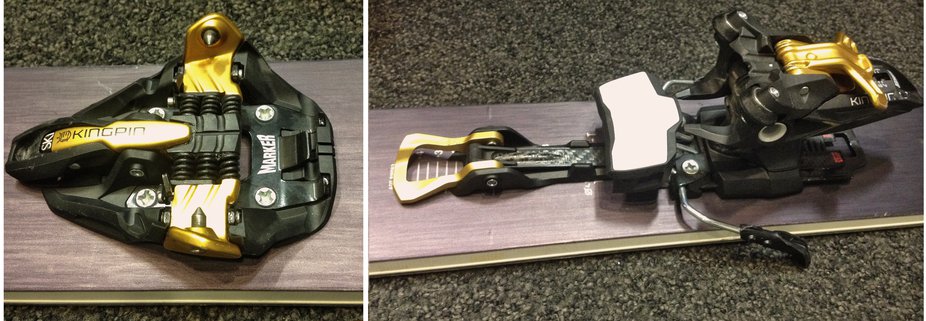
When the Kingpin was first announced this season it created quite a stir, mainly thanks to its whole new take on a tech binding.
It uses a fairly traditional Tech toe but does away with the pin heel altogether, instead favoring a heel much more similar to that found on an alpine binding. By doing so Marker have been able to combine the best elements of both alpine and tech bindings.
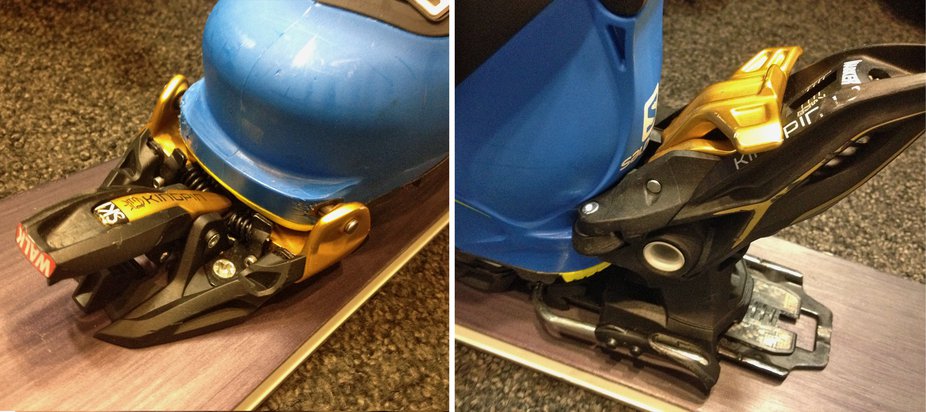
The toe functions just like a traditional tech binding, allowing the boot to pivot when in walk mode but the heel works like an alpine binding. You step down into the binding like you would any alpine binding and you also release the boot by pushing down the heel.

The binding on the left is in Ski mode and the one on the right is in Tour mode
When you are ready to tour, you first flip the heel down and then use the switch to slide the heel back out of the way, the brake is held out of the way by a small tab which you activate by standing or pushing down on the brake. When you are ready to ski again, flip the switch and the heel unit slides forward and the brake automatically re-engages.
The Kingpin does require a boot with tech inserts in the toe but most boots even if they have a short heel can be converted to work with the kingpin. A small metal piece can be added to the heel of short heeled touring boots to make up the volume of the heel required. It is worth checking your boots can work as not all will. The Atomic Backland for example, because of the way the heel works can not be converted to work with the Kingpin, so although most boots will work it is worth checking.
Perhaps most importantly Marker have been able to produce the Kingpin to DIN standards. They are producing both a 10 and a 13 DIN version and you can ride the same DIN setting you do your alpine bindings, so long as you ride under 13.
This is a massive factor for me. Being able to set the bindings to give consistent releases makes them so much safer in my opinion and in use I can honestly say they feel almost as solid as an alpine binding. Holding the heel down from above is so much more solid then the two pins used on tech bindings.
When I was testing them I forgot at times on was on a "Tech" binding and I was skiing things as hard as I would on my STH 16 steel's.
The Kingpin is a big deal in the touring market and if you are thinking of going tech but still want to ski hard I believe it is by far your best option and weighing only 730g still puts them far ahead of frame bindings and only slightly behind most traditional tech bindings.
Overall
So hopefully this has taken some of the mystery away from tech bindings. Obviously I only really covered the Radical but most tech bindings function in a pretty similar manner and once you have used one pair, you will easily be able to figure out the rest.
For uphill performance they are the best you can get, but they are held back with the downhill performance.
Products like the Beast and Vipec do improve on the original design but I strongly believe that kingpin really is a better way to go. Having skied both styles I would not personally buy any other binding then the Marker Kingpin for touring.
I think you will see a change in tech bindings over the next few years, I believe they will split into two groups. Your standard tech like a radical will still be the go to for climbing but I think we will see a new generation of "freeride tech" bindings following more closely along the lines of the Kingpin. I have heard about some of the new bindings in development can can assure you if the concepts work as planned it could be a very exciting time.
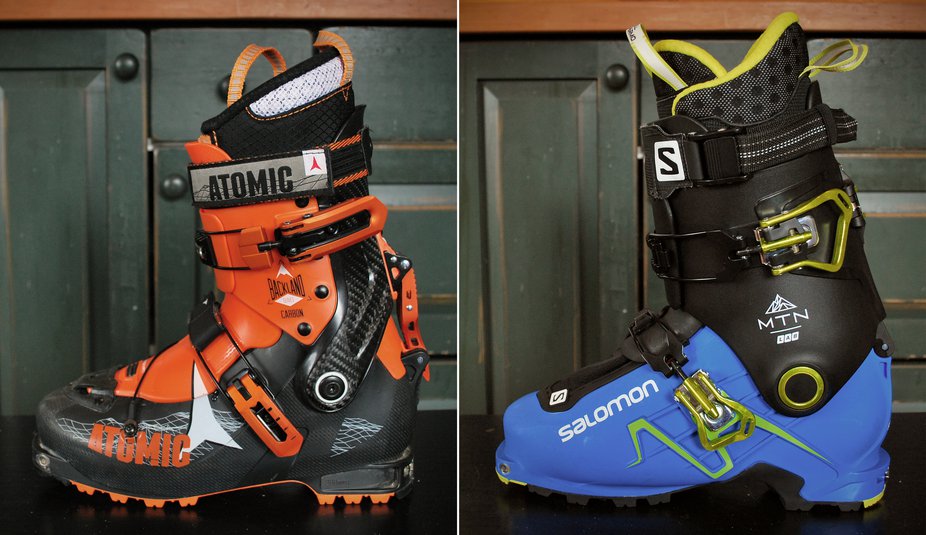
As I said at the start all this was to prepare you for tomorrow's boot reviews of the Salomon MTN Lab and the Atomic Backland. Both these boots are totally new products and are very different from what either brand has tried before. But getting into the touring market so late would they be playing catch up to the more established brands? Read my full reviews tomorrow to find out.

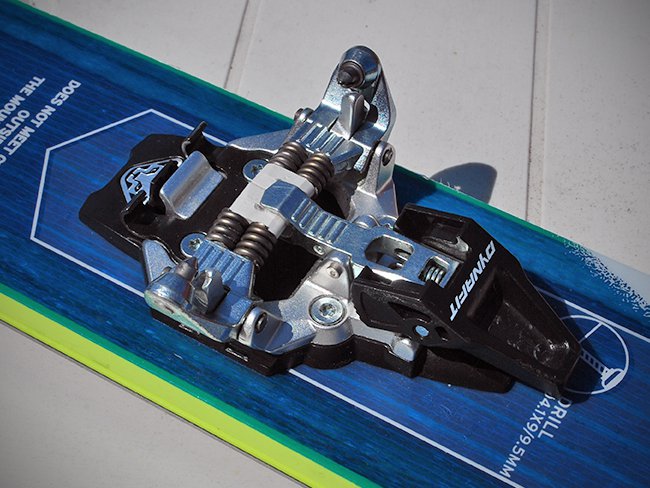
Comments